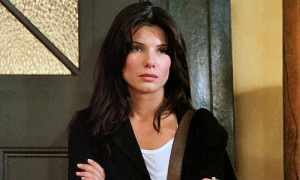Author John Grisham has mastered the ability to turn the would-be-dull rumblings of lawyers, judges, and juries into thrilling and gripping, edge of your seat, page-turning heavyweight novels, several of which (“The Firm,” “The Client,” “The Pelican Brief” to name a few) have been transformed into equally gripping (though never quite as good as the book) movies.
It’s been twenty-four years since Grisham’s debut novel, and the 1989 masterpiece “A Time to Kill” remains one of his best works. Seven years after the book, “A Time to Kill” reached the theatres, and the star-packed cast delivered a phenomenal film that does a successful job of following the book and leaves the audience gasping for breath with every scene that unfolds.Set in the fictitious town of Clanton, Mississippi (the setting for several other books written by the southern born Grisham, himself having grown up in Mississippi and a graduate of the prestigious Ole Miss Law School) the story follows the trial of a working class black man who has murdered the two drunken rednecks that raped and assaulted his ten-year-old daughter. The men are slain due to his perceived notion that they will receive an unfair trial because of the heavy racial tensions present in the Mississippi delta.
“A Time to Kill” is unique in that the viewer knows for certain what has happened in both crimes; the rape and subsequent murder, though the protagonists of the film can never be quite certain. “A Time to Kill” tackles several debatable and controversial issues; components of right and wrong, white and black, vigilante justice, and the very fabric of our legal system.
It’s a hot and humid summer afternoon in Clanton, Mississippi. Whist walking home from the market, ten-year-old Tonya Hailey is raped and beaten to near death by two racist rednecks, Billy Ray Cobb and Pete Willard, in between them gallivanting around town in a pickup truck marked with a Confederate flag, and guzzling cans of cheap beer. The men are later arrested by the town’s sheriff, Ozzie Walls (Charles S. Dutton) though the presiding notion is that they will easily beat the charges due to racial tensions in the region.

The trial of the men never occurs. En route to the preliminary proceedings, the father of Tonya, Carl Lee (Samuel L Jackson) emerges from the shadows of the courthouse lobby and opens fire, killing both men and seriously wounding a deputy (Chris Cooper). Carl Lee is arrested and having little funds, turns to Jake Brigance (Matthew McConaughey) a lawyer that once represented his brother. Opposing Jake and Carl Lee is District Attorney Rufus Buckley (Kevin Spacey) a previous courtroom rival of Jake’s. “He’s mean, he’s ambitious, and he’s gonna eat this up because of the publicity,” Jake explains to Car Lee. Winning will depend on the selection of the jury. “Pick the right jury and you walk. The DA picks the jury and you get the gas.”
Assisting Jake is his friend Harry Rex Vonner (Oliver Platt) a shady divorce attorney, Jake’s long time mentor Lucien Wilbanks (Donald Sutherland) a disbarred attorney, and Ellen Roark (Sandra Bullock) a mysterious law student from the north. As a hard lined southern judge named Omar Noose (Patrick McGoohan) resides over the courtroom battle between Jake and Rufus, Billy Ray’s brother Freddie Lee (Kiefer Sutherland) begins to terrorize Jake’s family from the outside.
“A Time to Kill” features one of the greatest dilemmas in the history of storytelling; the brutal rape that starts the movie has nothing to do with the trial of Carl Lee Hailey. Carl Lee is clearly guilty of the murders – but should a jury let him walk? Racial lines are drawn. The town of Clanton is divided. Half of the citizens protest outside the courthouse with signs reading, “Free Carl Lee” while the other half holds signs saying, “Fry Carl Lee.” The dilemma is summed up perfectly by Lucien when he advises Jake how strange the case is. “You can win, and justice will prevail. Or you could lose, and justice will prevail.”
“A Time to Kill” will keep you questioning your own beliefs and thoughts. You’ll wish to be on the jury and as far away from it at the same time. You can justify Carl Lee’s actions and chastise them. Though “A Time to Kill” is a great movie, the book is even better.
– by Matt Christopher
3 Comments
A little high on the grade but a nice review.
Pingback: » Captain America: The Winter Soldier (PG-13)
Pingback: » American Beauty (R)